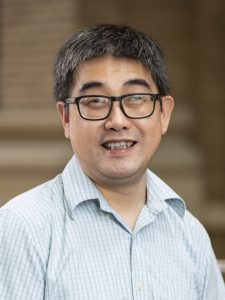Spotlight on Faculty – Li, Weikai
 For over 70 years, the anticoagulant Warfarin has been a first line defense used to treat and prevent heart attacks, strokes, and other cardiovascular diseases. Warfarin inhibits the Human Vitamin K Epoxide Reductase (VKOR) to hinder coagulation. However, despite being the most popular prescribed anticoagulant, Warfarin has a very narrow range of efficacy and overdose often induces severe, sometimes fatal bleeding. In older adults, one-third of hospitalization for adverse drug reaction are due to warfarin use.
For over 70 years, the anticoagulant Warfarin has been a first line defense used to treat and prevent heart attacks, strokes, and other cardiovascular diseases. Warfarin inhibits the Human Vitamin K Epoxide Reductase (VKOR) to hinder coagulation. However, despite being the most popular prescribed anticoagulant, Warfarin has a very narrow range of efficacy and overdose often induces severe, sometimes fatal bleeding. In older adults, one-third of hospitalization for adverse drug reaction are due to warfarin use.
The dichotomy between Warfarin’s beneficial and harmful effects has frustrated physicians and cardiovascular biologists alike for decades. Dr. Weikai Li, an Associate Professor of Biochemistry and Molecular Biophysics, took on the challenge of investigating the mechanism of Warfarin and other vitamin K antagonists.
To complicate the problem, the target of Warfarin, VKOR, is a small membrane protein that is extremely unstable and difficult to work with. However, this did not prevent Li from making strides in this field. His group are made of fearless, creative scientists who approach every new problem with great optimism. They are not afraid to invent new techniques.
“Some of these small membrane proteins are really difficult to obtain and crystalize because they are so unstable,” Li said. “So, we invented a new way of determining the structure.”
The Li lab not only develops novel methods that will be used by others for decades to come, but they also use their knowledge of the methods to make impactful scientific discoveries.
In order to study VKOR and other small membrane proteins, Li developed a novel technique to enable structural analysis of these proteins. This method involves securing a target’s conformation while preparing the protein for structural studies such as X-Ray Crystallography. This novel method, published in Science Advances, allows scientists to determine the structure of proteins at near-atomic resolution.
“We were able to stabilize the small membrane proteins,” Li said. “We came up with a way of using a coupler protein to restrain the two ends of a membrane protein so that it can still move but not too much to unfold. The couple protein also serves as a crystallization scaffold and facilitates the entire pipeline of structure determination”
Because of his efforts, Li and his team have produced the first structures of VKOR bound to various compounds similar to Warfarin, as well as VKOR with substrates captured in different stages of the catalytic cycle. Li and his collogues published their findings in Science. The group showed that Warfarin and compounds like mimic natural substrates of VKOR at the local and global level to achieve tight binding, preventing coagulation in patients for long periods of time. Li suggested that his work may lead to improved antidotes that can outcompete Warfarin and stop dangerous levels of bleeding in patients experiencing Warfarin overdoses and side effects.
Li has not only solved this structure, but the lab has achieved an additional unbelievable feat: solving more than 15 small membrane protein structures in a short amount of time. These include the structure of CD53, published in EMBO J, the first one ever captured in active conformation for the entire tetraspanin family, and that of SPCS1, a human factor required for the maturation process of Zika and other flaviviruses.
His expertise is clear as seen by his guest editorial entitled “Integral Membrane Enzymes” in the Journal of Molecular Biology.
In addition to all of his duties as an Associate Professor, Li still finds time to perform experiments and structural analyses. He can be found doing many things ranging from making CRISPR cell lines to solving structures on the computer.
“I love what I do because of the pure scientific excitement,” Li said. “The first day that you see the electron density of a protein structure that is long-sought-after; that’s the most thrilling part in life.”
Written by Marissa Locke, 4 January 2021
Ms. Locke is a fourth-year graduate student in the Immunology program. She is completing her thesis work in the laboratory of Dr. Deborah Lenschow.
